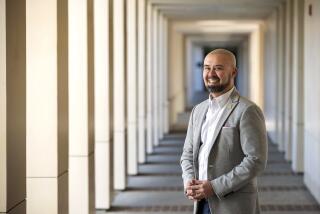Helping College Newcomers Get It Together
- Share via
Two years ago, Rachael Williams suffered the fate of many college students: She had too many final exams and not enough time to study.
After finishing one final at 9:30 p.m., Williams, then an Occidental College freshman, wanted to go to bed and forget about her morning final. But her roommates wouldn’t let her. They made her study until 3 a.m.
“We had popcorn and shakes,” said Williams, now a junior biochemistry major. “It was really nice because I felt everyone understood my situation. Did it help? I got an A” on the morning final.
Williams, who lives in Reseda, attributes her A and her roommates’ concern to their participation in a new program that requires freshmen to be both roommates and classmates at the small liberal arts college, which is in Los Angeles’ Eagle Rock neighborhood.
“If you’re brushing your teeth” next to someone in your class, “you tend to talk about the classwork,” said Occidental President Theodore R. Mitchell.
The Learning and Living program attempts to make the transition to college life easier by helping students better connect with their surroundings and by providing peer support to help them become better students.
The program, ending its first official year, requires incoming freshmen to attend at least one “core” seminar in a classroom and then to live with their seminar classmates in the same residential hall.
Officials said the arrangement works at Occidental because freshmen are already required to live in campus dormitories. It has been that way since 1926, when 737 students were enrolled there.
Today, about 1,800 students are enrolled.
The program has had promising results, officials said.
First-year students are connecting more easily with their peers and professors, making the transition to college life far easier for them than at other schools, officials and students said.
In addition, the college’s dropout rate for freshmen has decreased dramatically, in large part because of the program. Nearly 5% of freshmen didn’t return after the 1999 fall semester. By the fall of 2002, the dropout rate among freshmen dropped to just over 1.5%, officials said.
About a third of Occidental’s freshmen are people of color, making its Learning and Living program one of the most diverse in the United States, said Eric Newhall, director of the Occidental program.
There even seems to be less damage to the dorm rooms and other facilities by first-year students in the program, officials said.
“There is going to be some horseplay,” said Rameen Talesh, associate dean and director of residence and Greek life. “But the students are holding themselves to be more accountable. If someone is acting out of line, they’re able to come in and give a peer perspective.”
The Learning and Living concept isn’t new. It’s been around since the 1960s. It faded out in the ‘70s, but surged back in the ‘80s.
According to the National Learning Communities Project at Evergreen State College in Olympia, Wash., more than 600 U.S. colleges and universities use some variation of it.
Stanford University, which also requires freshmen to live on campus, offers a variety of programs, including one that allows freshmen to take 12 of their 16 units each quarter with their dorm classmates. The option is enhanced by the access to a faculty member or a senior program staffer, who also lives in the dorm.
At the University of Wisconsin’s Madison campus, more than 100 female students interested in science and engineering are housed together in a single dorm to foster common academic interest and a good studying environment.
Meanwhile, Occidental’s program seems to be a hit with the freshmen.
“I thought it was a pretty cool idea,” said Matt Srsich, a 19-year-old from North Royalton, Ohio, who just completed his freshman year. “I had never heard of anything like this before.”
Living with the people taking the same seminar “made the class so much easier and worthwhile,” Srsich said.
Others agreed.
“I guess the comfort factor was the biggest thing for me,” said freshman Surya Kalra, 18, from Sterling, Ill. “We were all in different levels, and it helps that people cared about you in class.”
She said the program “made us more respectful of each other.”
More to Read
Sign up for Essential California
The most important California stories and recommendations in your inbox every morning.
You may occasionally receive promotional content from the Los Angeles Times.










